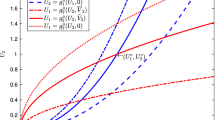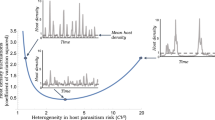Summary
Simulation model for niche shift in ecological time scale was constructed on the basis of the optimal foraging theory. In accordance with the previous experimental study (Shimada andFujii, 1985), the model competitive system consisted of 2 parasitoid wasp species utilizing 4 host stages. Wasps were assumed to choose host stages in the manner that they realized the maximal gain/cost values, where gain was represented by body weight of a wasp progeny emerging from each host stage and cost was expressed by time required to search for and detect an unparasitized host. The number of parasitized hosts in each host stage was calculated numerically by usingArditt's (1983) model for avoidance of superparasitism.
The model simulated well the experimental results ofShimada andFujii (1985) andShimada (1985). Sensitivity analysis of the model showed that the experimentally derived criterion for competitive coexistence (different second-best host stages between competing species even with the common best) was not necessarily the indispensable condition for niche shift and separation, but that if the criterion was not satisfied, stable competitive coexistence occurred only in the narrow range of the parametric values. Further, niche shift in ecological time scale made the competitive coexistence more stable than fixed niche on which the current niche theory stands.
Similar content being viewed by others
References
Abrams, P. (1975) Limiting similarity and the form of the competition coefficient.Theor. Popul. Biol.8: 356–375.
Abrams, P. (1980) Are competition coefficients constant? Inductive versus deductive approaches.Amer. Natur.116: 730–735.
Abrams, P. (1983) The theory of limiting similarity.Ann. Rev. Ecol. Syst.14: 359–376.
Arditi, R. (1983) A unified model of the functional response of predators and parasitoids.J. Anim. Ecol.52: 293–303.
Brew, J. S. (1982) Niche shift and the minimization of competition.Theor. Popul. Biol.22: 367–381.
Christiansen, F. B. andT. M. Fenchel (1971)Theories of population in biological communities. Springer-Verlag, Berlin.
Dunham, A. E. (1983) Realized niche overlap, resource abundance and intensity of interspecific competition. 261–280. InR. B. Huey, E. R. Pianka, andT. W. Schoener (eds)Lizard ecology: studies of a model organism. Harvard Univ. Press, Cambridge.
Holling, C. S. (1959) Some characteristics of simple types of predation and parasitism.Can. Entomol.91: 385–398.
Krebs, J. R. (1978) Optimal foraging: decision rules for predators. 23–63. InJ. R. Krebs andN. B. Davies (eds)Behavioural ecology: an evolutionary approach. Blackwell, Oxford.
Lawlor, L. (1980) Overlap, similarity, and competition coefficients.Ecology61: 245–251.
Levins, R. (1968)Evolution in changing environments: some theoretical explorations. Princeton Univ. Press. Princeton.
MacArthur, R. H. (1969) Species packing, and what interspecies competition minimizes.Pro. Natl. Acad. Sci. U.S.A.64: 1369–1371.
MacArthur, R. H. (1972)Geographical ecology: patterns in the distribution of species. Harper and Row, New York.
MacArthur, R. H. andR. Levins (1967) The limiting similarity, convergence, and divergence of coexisting species.Amer. Natur.101: 377–385.
May, R. M. (1974)Stability and complexity in model ecosystems (2nd ed.). Princeton Univ. Press, Princeton
May, R. M. (1981) Models for two interacting populations. 78–104. InR. M. May (ed)Theoretical ecology: principle and applications (2nd ed.). Blackwell, Oxford.
Pianka, E. R. (1973) The structure of lizard communities.Ann. Rev. Ecol. Syst.4: 53–74.
Pianka, E. R. (1978)Evolutionary ecology (2nd ed.). Harper and Row, New York.
Pianka, E. R. (1981) Competition and niche theory. 167–196. InR. M. May (ed)Theoretical ecology: principles and applications (2nd ed.). Blackwell, Oxford.
Pyke, G. H., H. R. Pulliam andE. L. Charnov (1977) Optimal foraging: a selective review of theory and tests.Quart. Rev. Biol.52: 137–154.
Rogers, D. J. (1972) Random search and insect population models.J. Anim. Ecol.41: 369–383.
Royama, T. (1971) A comparative study of models for predation and parasitism.Res. Popul. Ecol. Suppl.1: 1–91.
Schoener, T. W. (1982) The controversy over interspecific competition.Amer. Sci.70: 586–595.
Shimada, M. andK. Fujii (1985) Niche modification and stability of competitive systems. I. Niche modification process.Res. Poul. Ecol.27: 185–201.
Shimada, M. (1985) Niche modification and stability of competitive systems. II. Persistence of interspecific competitive systems with parasitoid wasps.Res. Popul. Ecol.27: 203–216.
Sih, A. (1982) Optimal patch use: variation in selective pressure for efficient foraging.Amer. Natur.120: 666–685.
Townsend, C. R. andA. G. Hildrew (1979) Resource partitioning by two freshwater invertebrate predators with contrasting foraging strategies.J. Anim. Ecol.48: 909–920.
Author information
Authors and Affiliations
Rights and permissions
About this article
Cite this article
Shimada, M., Fujii, K. Niche modification and stability of competitive systems. III. Simulation model analysis. Res Popul Ecol 27, 217–230 (1985). https://doi.org/10.1007/BF02515462
Issue Date:
DOI: https://doi.org/10.1007/BF02515462




